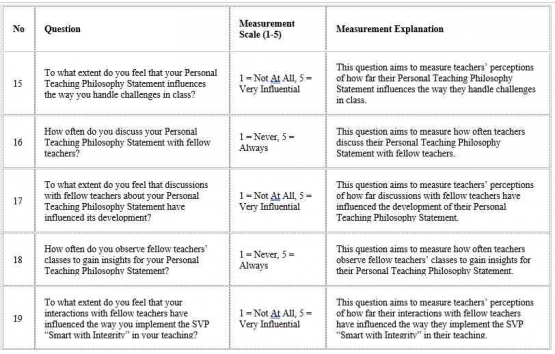


The measurement scale is a Likert scale, where respondents are asked to rate each statement on a scale from 1 to 5.
Referensi:
1. Alexander, M. (2017). School Mission Statements: A Content Analysis. Journal of Educational Leadership and Policy Studies, 2(1), 94-110.
2. Chism, N. V. N. (1998). Developing a Teaching Philosophy: A Guide for Graduate Students. College Teaching, 47(4), 136-142.
3. Dearden, R. (2016). The significance of teacher beliefs in a TESOL context: A qualitative study of ESL instructors' beliefs. TESOL Quarterly, 50(1), 181-209.
4. Stevens, D. D., & Cooper, J. E. (2009). The Teaching Philosophy Statement as Reflective Practice. Teaching and Learning Inquiry, 1(1), 63-74.
3. Koob, J. J., & Rule, A. C. (2017). Developing a Teaching Philosophy Statement: A Writing Across the Curriculum Approach. The Journal of Faculty Development, 31(1), 47-54.
4. Paul, R., & Elder, L. (2006). Critical thinking: The nature of critical and creative thought. Journal of Developmental Education, 30(2), 34-35.
Follow Instagram @kompasianacom juga Tiktok @kompasiana biar nggak ketinggalan event seru komunitas dan tips dapat cuan dari Kompasiana. Baca juga cerita inspiratif langsung dari smartphone kamu dengan bergabung di WhatsApp Channel Kompasiana di SINI












